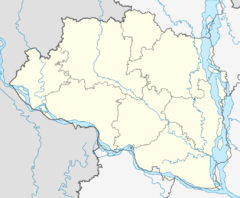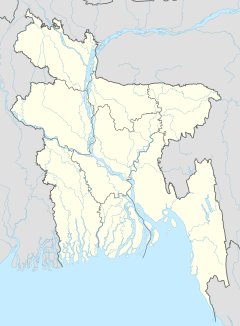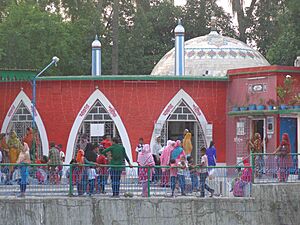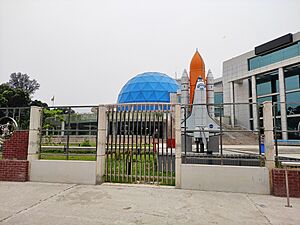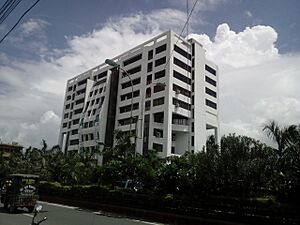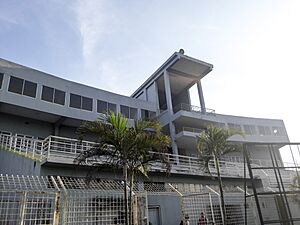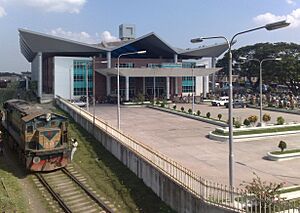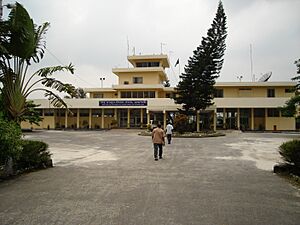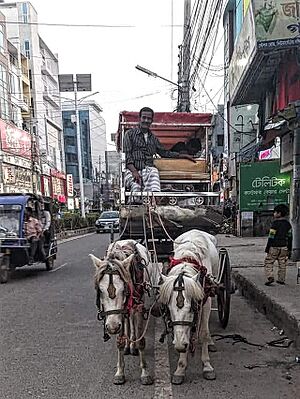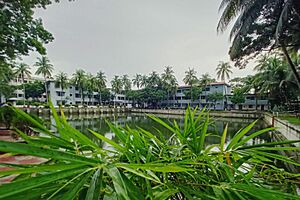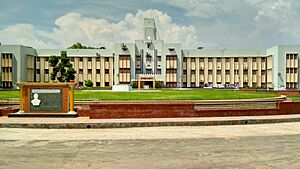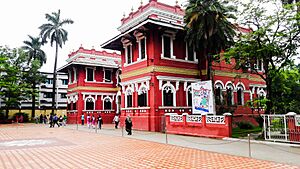Rajshahi facts for kids
Quick facts for kids
Rajshahi
রাজশাহী
|
|
|---|---|
|
Skyline of Shaheb Bazar
Administration Building of Rajshahi College
Varendra Research Museum
|
|
| Nickname(s):
Education City, Silk City, City of Mango, Green City, Clean City
|
|
| Country | |
| Division | Rajshahi |
| District | Rajshahi |
| Establishment | 1634 |
| Municipality | 1876 |
| Granted city status | 1991 |
| Government | |
| • Type | Mayor-Council |
| • Body | Rajshahi City Corporation |
| Area | |
| • Metropolis | 120.98 km2 (46.71 sq mi) |
| Area rank | 04 |
| Elevation | 18 m (59 ft) |
| Population
(2024)
|
|
| • Urban | 985,000 |
| • Metro | 1,000,000+ |
| • City rank | 6th in Bangladesh |
| • Metro rank | 6th in Bangladesh |
| Languages | |
| • Official | Bengali • English |
| Time zone | UTC+6 (BST) |
| Postal code |
6000, 6100, 6203
|
| UN/LOCODE | BD RJH |
| Calling Code old | 0721 |
| Calling Code new | 025888 |
| Police | Rajshahi Metropolitan Police |
| Airport | Shah Makhdum Airport |
| Metropolitan Planning Authority | Rajshahi Development Authority |
| Water Supply and Sewerage Authority | Rajshahi WASA |
Rajshahi (Bengali: রাজশাহী, [radʒ.ʃaɦi]) is a big city in Bangladesh. It is a major center for city life, government, business, and education. Rajshahi is also the main city for its division and district.
The city sits on the north bank of the Padma River, close to the border with India. It is surrounded by the towns of Nowhata and Katakhali. Together, these areas form a large urban region with about 1 million people. Rajshahi is sometimes called the City of Education because it has many famous schools. It is also known as the Silk City for its silk production, the City of Mango for its delicious mangoes, and the Green City and Clean City for its environment.
Rajshahi has a long history. It was founded in 1634. The city became a municipality during the British Raj in 1876. Today, it is home to the Varendra Research Museum, the oldest museum of its kind in Bangladesh. The main office of the Rajshahi Krishi Unnayan Bank is also here. Shah Makhdum Airport serves the city. The Guardian newspaper has called Rajshahi the cleanest city in Bangladesh.
Contents
- History of Rajshahi
- Geography and Climate
- Parks and Fun Places
- Interesting Places to Visit
- Administration and Governance
- Economy and Business
- Culture and Celebrations
- Transportation in Rajshahi
- Healthcare Facilities
- Population and Languages
- Education City
- Famous People from Rajshahi
- Sister City
- Images for kids
- See also
History of Rajshahi
Ancient Times and Early Rulers
The Rajshahi area was once part of the ancient Pundra Kingdom in Bengal. The capital of Prince Vijaya, a king who led military actions in Sri Lanka, was located about 14 kilometers west of Rajshahi town.
Different kings and local rulers called Zamindars controlled Rajshahi. During the time of Deo Raja, the region was known as Mohakalgarh. In 1288-89, Shah Makhdum Rupos defeated the Raja.
Naming the City
Later, the region was called Rampur Boalia after an administrative office was set up in 1825. The exact origin of the name "Rajshahi" is still discussed by experts. Most believe it comes from the Hindu Kings (or "Rajas") of the Rajshahi Raj. The word Raj means "royal" or "kingdom," and Shahi is a Persian word also meaning "royal."
The administrative district of Rajshahi was created in 1772. The city's municipal corporation was formed in 1876.
British Rule and Development
During the British Raj, Rajshahi was also known as "Beuleah." It was the main administrative center for the Rajshahi district. The British first chose it as a business center for the silk trade. They wanted to encourage silk farming.
The town had a government college and a school for sericulture (silk worm farming). Many public buildings were badly damaged by a large earthquake on June 12, 1897. In the early 1900s, there was a daily steamer service on the Ganges River. This connected Rajshahi to train lines that went to Calcutta and other cities in Bengal.
Modern History
Rajshahi faced challenges during the Bangladesh Liberation War. The city became a city corporation in 1991.
Geography and Climate
Where is Rajshahi Located?
Rajshahi is located in the Barind Tract area. It is about 23 meters (75 feet) above sea level. The city is on the flat land near the Padma River, which flows along its southern side.
To the east, north, and west, Rajshahi is surrounded by Paba Upazila, which is a smaller administrative area. The wider Rajshahi District is bordered by Naogaon District to the north, Natore District to the east, and Chapai Nawabganj District and the Padma River to the south.
Rajshahi's Weather
Rajshahi has a tropical wet and dry climate. This means it has a hot season, a monsoon season, and a cooler dry season. The hot season starts in early March and lasts until mid-July. Temperatures can reach about 32 to 36 degrees Celsius (90 to 97 degrees Fahrenheit) during these months.
The coolest month is January, with temperatures around 7 to 16 degrees Celsius (45 to 61 degrees Fahrenheit). Most of the rain falls during the monsoon season. The city gets about 1448 millimeters (57 inches) of rain each year.
| Month | Jan | Feb | Mar | Apr | May | Jun | Jul | Aug | Sep | Oct | Nov | Dec | Year |
|---|---|---|---|---|---|---|---|---|---|---|---|---|---|
| Record high °C (°F) | 31.6 (88.9) |
36.8 (98.2) |
40.5 (104.9) |
42.7 (108.9) |
45.1 (113.2) |
43.6 (110.5) |
39.7 (103.5) |
38.3 (100.9) |
37.9 (100.2) |
36.5 (97.7) |
34.3 (93.7) |
30.3 (86.5) |
45.1 (113.2) |
| Mean daily maximum °C (°F) | 23.7 (74.7) |
27.9 (82.2) |
33.0 (91.4) |
35.8 (96.4) |
35.3 (95.5) |
34.3 (93.7) |
33.0 (91.4) |
33.2 (91.8) |
33.0 (91.4) |
31.9 (89.4) |
29.4 (84.9) |
25.4 (77.7) |
31.3 (88.3) |
| Daily mean °C (°F) | 16.2 (61.2) |
20.0 (68.0) |
25.0 (77.0) |
28.7 (83.7) |
29.3 (84.7) |
29.5 (85.1) |
28.9 (84.0) |
29.1 (84.4) |
28.5 (83.3) |
26.7 (80.1) |
22.4 (72.3) |
18.0 (64.4) |
25.2 (77.3) |
| Mean daily minimum °C (°F) | 10.4 (50.7) |
13.4 (56.1) |
18.2 (64.8) |
22.9 (73.2) |
24.6 (76.3) |
26.0 (78.8) |
26.3 (79.3) |
26.4 (79.5) |
25.8 (78.4) |
23.1 (73.6) |
17.4 (63.3) |
12.7 (54.9) |
20.6 (69.1) |
| Record low °C (°F) | 3.4 (38.1) |
4.6 (40.3) |
8.6 (47.5) |
10.8 (51.4) |
14.4 (57.9) |
20.3 (68.5) |
19.4 (66.9) |
18.3 (64.9) |
15.8 (60.4) |
11.4 (52.5) |
7.0 (44.6) |
4.2 (39.6) |
3.4 (38.1) |
| Average precipitation mm (inches) | 7 (0.3) |
13 (0.5) |
25 (1.0) |
58 (2.3) |
143 (5.6) |
231 (9.1) |
289 (11.4) |
222 (8.7) |
255 (10.0) |
114 (4.5) |
12 (0.5) |
7 (0.3) |
1,376 (54.2) |
| Average precipitation days (≥ 1 mm) | 2 | 2 | 3 | 5 | 10 | 14 | 20 | 17 | 15 | 7 | 1 | 1 | 97 |
| Average relative humidity (%) | 78 | 71 | 63 | 65 | 75 | 83 | 87 | 86 | 86 | 83 | 78 | 78 | 78 |
| Mean monthly sunshine hours | 201.7 | 226.0 | 252.6 | 236.7 | 220.6 | 173.1 | 152.1 | 163.8 | 173.3 | 228.3 | 235.5 | 211.0 | 2,474.7 |
| Source 1: NOAA | |||||||||||||
| Source 2: Bangladesh Meteorological Department (humidity 1981-2010) | |||||||||||||
Rajshahi has worked hard to improve its air quality. Since 2014, air pollution has been greatly reduced. This was done by using cleaner fuels, battery-powered vehicles, paving dirt roads, encouraging walking and biking, and planting more trees.
Parks and Fun Places
Green Spaces in Rajshahi
Shaheed A.H.M Qamaruzzaman Central Park and Zoo is a very popular place in Rajshahi. It is a large area with many green trees and grassy spaces. The park is home to different kinds of animals. It is located right by the Padma River.
Other parks in the city include Bhubon Mohon Park and Captain Monsur Ali Park. Shahid Zia's Children's Park is made especially for kids to have fun. The banks of the Padma River are also great for relaxing. Many parts of the riverbank have been designed for people to enjoy the views. Munsguard Park and Lalonshah Park were built in 2015 along the river.
Interesting Places to Visit
- Banks of the Padma River: The Padma River is one of the biggest rivers in South Asia. You can see it flowing by the southern side of the city. During the monsoon season, the river's water level rises.
- Varendra Research Museum: This museum was started in 1910. It focuses on ancient history and culture. It has many old items from Hindu, Buddhist, and Muslim heritage, some from as far back as the 16th century. The museum is in the city center.
- Shrine of Shah Makhdum Rupos: This is a special tomb (called a dargah) built in 1635 for Shah Makhdum. He was the first person to teach Islam in this area. A legend says he arrived by riding on two crocodiles down the Padma River. To remember this story, some crocodiles are kept in a pond next to the shrine.
- Shaheed A.H.M Qamaruzzaman Central Park and Zoo: This park is a large green area with trees and grass. Its zoo has many different animal species. It is located next to the Padma River.
- Shahid Zia Park: An amusement park with fun rides like a mono rail and bumping cars. The Rajshahi City Corporation manages it.
- University of Rajshahi: This large university campus is just a few kilometers from the city center. It is the second-largest university in Bangladesh.
- Shaheb Bazar: This is the heart of the city. You will find most of the shopping malls and business buildings here.
- Ghoramara: This is the oldest part of Rajshahi City. It has many buildings that are 70 to 100 years old.
- Boro Kuthi: Inside the Barakuthi area, there is a small cemetery with graves from the 1800s. There are 14 tombs there.
- Upashohor: This is a planned, modern town area. The Rajshahi Cantonment (a military base) is next to it.
- Motihar: Rajshahi University is located here on a big campus surrounded by mango trees.
- Kashia-Danga: This is where the huge mango tree gardens of Rajshahi begin. It is in the western part of the city.
- Santal Para: Located inside the Mahish-Bathan Area. Some people from the Santal tribe live here.
- Bangabandhu Novo Theatre, Rajshahi: A new planetarium is being built here.
Administration and Governance
Rajshahi is the main city for one of the eight administrative divisions of Bangladesh. The Divisional Commissioner, who is the top administrator for Rajshahi Division, has an office here. Other government officials also work in the city.
The Deputy Commissioner (DC) for Rajshahi District also has an office in the city. Judges and magistrates have their offices here too.
Rajshahi is one of seven metropolitan cities in Bangladesh. The city is governed by the Rajshahi City Corporation. A mayor and 30 ward commissioners are chosen by direct votes every five years. The City Corporation handles all administrative tasks for the city.
The Rajshahi Metropolitan Police (RMP) keeps law and order and manages traffic in the city. The Rajshahi Development Authority (RDA) plans and organizes development projects. Rajshahi WASA is in charge of the city's water supply and drainage systems.
Economy and Business
Rajshahi has been famous for its silk fabrics since the British era. This special silk is known as Rajshahi silk. There are also several jute mills in the city. Many glass-making factories have been built recently.
The Rajshahi City Corporation has built an industrial city called BSIC Industrial City-02. A leather industry area is also being developed. There will also be a large industrial zone covering 1,200 acres.
The Bangabandhu Hi-Tech Park will be very important for developing technology in Rajshahi. When finished, it is expected to create about 50,000 jobs in information and communication technology. There are also plans to build another economic zone on a sandbar (char) in the Padma River. This could become a major business hub for North Bengal.
Culture and Celebrations
Arts and Festivals in Rajshahi

Rajshahi is well-known for its Rajshahi silk, which is a special clothing material in the Indian subcontinent. The city is also famous for having the best mangoes and lichis in the region.
The Barendra Museum in Rajshahi is known for its collection of local sculptures and other old items from medieval times. The city also has important buildings made by the British, like the T Dam.
People in Rajshahi celebrate many festivals. Pohela Baishakh, the Bengali New Year, is celebrated with great joy. Pahela Falgun, the first day of spring in the Bengali calendar, is also a festive day.
Major Muslim festivals like Eid ul-Fitr, Eid ul-Adha, and Muharram are widely celebrated. Hindu festivals like Durga Puja, the Buddhist festival of Buddha Purnima, and the Christian festival of Christmas are also celebrated across the city.
Media and News
Many Bengali daily newspapers are published in Rajshahi. These include Sonali Sangbad, Uttorbongo Protidin, Sunshine, Dainik Barta, Sonar Desh, Natun Provat, and Amader Rajshahi. There are also many online news websites like Uttarkal and Padmatimes24.
The government-run Bangladesh Television and Bangladesh Betar (radio) have broadcasting centers in Rajshahi. Local FM radio stations like Radio Padma (99.2 MHz) and Radio Foorti (88.0 MHz) also broadcast here.
Rajshahi City has five press clubs for journalists: Rajshahi City Press Club, Rajshahi Press Club, Rajshahi Metropolitan Press Club, Rajshahi Varendra Press Club, and Rajshahi Padma Press Club.
Sports in Rajshahi
The city has three large stadiums, each able to hold over 15,000 people. One is the Rajshahi District Stadium in the city center. Another is inside Rajshahi University. The third, used for cricket, is called Shaheed Qamaruzzaman Stadium. Rajshahi also has an international standard tennis complex and several sports training academies.
Many national-level footballers have come from Rajshahi. These include former Bangladesh national team captain Mohammed Mohsin and midfielder Manik Hossain Molla. The city has several club teams like Diganta Proshari Sangha. There are also football training academies.
Rajshahi is an important place for cricket in Bangladesh. It provides many players to the national team. The city is also home to the Bangladesh Premier League team Rajshahi Kings. Two cricket academies, Banglatrack and Clemon, help train new cricketers.
Hockey is also popular in Rajshahi. Many local hockey clubs play at national, university, college, and school levels. National team hockey players have come from Rajshahi.
Transportation in Rajshahi
Road Travel
Rajshahi is connected to most parts of Bangladesh by the N6 national highway. The city has two intercity bus terminals. It takes about 5 to 6 hours to reach the capital city Dhaka by road. Many bus services, including air-conditioned ones, travel to and from Dhaka. Buses also connect Rajshahi to other major cities and district headquarters.
Train Travel
Bangladesh Railway operates four inter-city train services between Dhaka and Rajshahi railway station. These trains are named Silk City Express, Padma Express, Dhumketu Express, and Bonolota Express. Other trains connect Rajshahi to Khulna and other regions. There are two other railway stations in the city: Rajshahi Court and Rajshahi University.
Air Travel
The city is served by Shah Makhdum Airport. It is named after the Islamic preacher Shah Makhdum Rupos. The airport is located in Nowhata, a town near the city. Biman Bangladesh Airlines, Novoair, and US-Bangla Airlines offer domestic flights to and from Dhaka.
Getting Around the City
Auto rickshaws and charging rickshaws are the main ways to get around within Rajshahi. In the past, there were many Tomtoms (horse-driven carts), and you can still find a few today.
There are also some bus and minibus services on certain routes, connecting to areas outside the city center. Many rental car companies operate in the city, offering sedans, SUVs, and micro-buses for hire. Ride-sharing services like Uber and Obhai are also available.
Healthcare Facilities
Rajshahi has many hospitals run by the government, private organizations, and NGOs. Rajshahi Medical College Hospital (RMCH) is a large public hospital. It also serves as a teaching facility for medical students.
There are two private medical college hospitals in the city, with two more being built. Rajshahi also has a government-run children's hospital, a chest hospital, a district-level government hospital, and a Christian missionary hospital.
Population and Languages
| Religions in Rajshahi city (2011) | ||||
|---|---|---|---|---|
| Religion | Percent | |||
| Islam | 93.86% | |||
| Hinduism | 5.38% | |||
| Christianity | 0.44% | |||
| Other or not stated | 0.32% | |||
In 2011, Rajshahi had a population of 449,756 people living in 99,545 homes. For every 1000 males, there were 930 females. The literacy rate (people who can read and write) was 74.1%.
Bengali is the main language spoken by the people of Rajshahi. Many different Bengali dialects and regional languages are also used. There is a small group of people who speak Urdu. They are descendants of Muslims who moved here during the separation of India and Pakistan in 1947.
Education City
Rajshahi is often called the "Education City" because it has many government and private schools and colleges. Rajshahi College is the third oldest college in Bangladesh. Rajshahi Medical College is the second oldest medical college in what was once East Pakistan.
The University of Rajshahi is the second oldest and one of the largest public universities in the country. Rajshahi Engineering College, now known as RUET, was the second engineering college built in East Pakistan in 1964. For technical education, Rajshahi Polytechnic Institute was established in 1963.
Major Educational Institutions
- Rajshahi Polytechnic Institute (RPI)
- University of Rajshahi(RU)
- Rajshahi University of Engineering and Technology(RUET)
- Rajshahi Medical College(RMC)
- Rajshahi College(RC)
- Rajshahi Government City College(RGCC)
- New Government Degree College, Rajshahi(NGDC)
- Rajshahi Cadet College, Rajshahi
- Rajshahi Shikkha Board Government Model School & College
- Rajshahi Cantonment Public School & College
- Rajshahi Collegiate School
- Govt. Promoth Nath Girls' High School, Rajshahi
- Rajshahi Govt. Girls' High School, Helenabad
- Rajshahi Government Model School & College
- Rajshahi Mohila Polytechnic Institute
- Rajshahi Polytechnic Institute
- Government Women's College, Rajshahi
- Barind Medical College
- Seroil Government High School, Rajshahi
- Government Laboratory High School Rajshahi
- Agrani School and College, Rajshahi
- Rajshahi University School
- Haji Abul Hossain Institute of Technology, Rajshahi
- Higher Secondary Teacher's Training Institute
- Haji Muhammad Mohsin Government High School
- Islami Bank Medical College
- Mohanogor College, Rajshahi
- North Bengal International University
- Nowhata Govt. Degree College, Nowhata, Rajshahi
- Shah Mokhdum College
- Shah Mokhdum Medical College
- Silk Research and Training Institute
- Shahid A.H.M Kamruzzaman Government Degree College
- Teacher's Training College
- Udayan Dental College
- Varendra Government College, Rajshahi
- Uposhohor Housing Estate Girls' High School, Rajshahi
- Varendra University
Famous People from Rajshahi
Many notable people have come from Rajshahi, including:
- A.H.M. Quamruzzaman, a politician
- Ritwik Ghatak, a filmmaker
- Hasan Azizul Huq, a linguist
- Andrew Kishore, a singer
- Rajanikanta Sen, a poet
- Akshay Kumar Maitreya, a historian
- Khaled Mashud, a cricketer
- Ila Mitra, an activist
- Sabbir Rahman, a cricketer
- Sir Jadunath Sarkar, a historian
- Mohammad Shamsuzzoha, an academic
- Mohammed Mohsin, a footballer
- Manik Hossain Molla, a footballer
- Junaid Siddique, a cricketer
- Najmul Hossain Shanto, a cricketer
- Mahiya Mahi, an actress
- Mrinal Haque, a sculptor
Sister City
Rajshahi has one sister city:
 Kristiansand, Norway (since 1979)
Kristiansand, Norway (since 1979)
Images for kids
-
View of Rajshahi city from the Padma River
See also
 In Spanish: Rajshahi para niños
In Spanish: Rajshahi para niños





